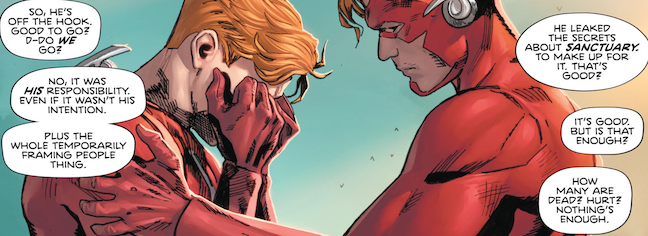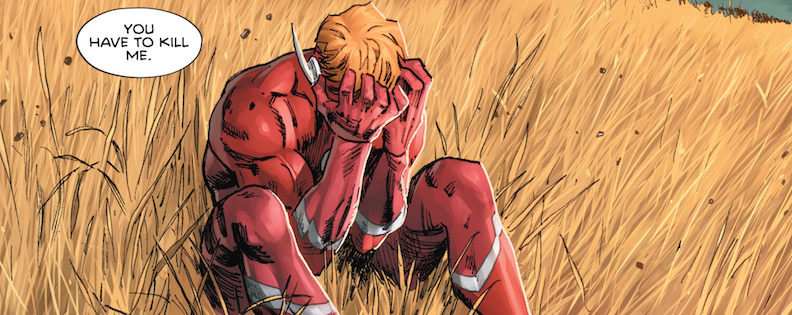Is Wally West a villain now? Tom King’s exploration of what it means to troubled with superpowers misses its mark as the miniseries comes to its conclusion.
Heroes in Crisis 9
Written by Tom King
Pencils and Inks by Clay Mann
Colors by Tomeu Morey
There was a lot of potential here. When this series was originally announced, it was hyped as an exploration of how the superhero community deals with problems that are more emotional in nature. This could have been an essential deep dive into depression and mental illness, a revealing look into the fact that even people that seemingly have it all can be brought down by doubt or emotional fatigue.
I’m not really a fan of injecting real-world problems into my funny books. I appreciate the escapism of men and women doing good in the world because they can. It takes my mind off the increasingly angry state of the world. But as someone who has spent countless years dealing with depression, I can appreciate the potential for what HEROES IN CRISIS could have brought to the table.
As a whole, it makes sense, I suppose. Wally West, since he returned in the DC UNIVERSE REBIRTH special, has not had the easiest time. He lost his kids and his wife and his place in the world when Doctor Manhattan wiped 10 years away. He came back to a world that had moved on without him and he hasn’t been able to find his way to being comfortable again.
If King had used this as an examination of what that can do to someone, with a detailed focus on Wally West, this could have maybe lived up to the potential. But what we got instead was the worst kind of superhero comic book schlock, filled with tropes about time travel, red herrings and entire issues that were just meant to pad out the story.

No, Wally West isn’t dead, as seen in the FIRST ISSUE. But he did murder a whole lot of other heroes before plotting to kill himself and reveal all of Sanctuary’s secrets as a way to make good for what he did. Why is he not dead? Because of wacky comic book time travel loopholes that not even the characters in the book seem to understand. Wally ends up in solitary confinement, paying for what he did, which seems like the absolute worst, cruelest thing heroes could do to one of their own who is clearly suffering from depression.
Another thing that kind of sticks in my craw about this final issue – and the series as a whole – is the missed opportunity to try and help others. Depression and emotional fatigue are a big part of King’s story, and it’s something that a lot of people suffer through. Many of those people suffer silently, feeling as alone as Wally did and not feeling like they had anyone with whom they could have a conversation about what they’re going through.
So why not partner with the National Suicide Prevention Lifeline? Why not include a message about who you can turn to when you’re in need? Instead of using the back pages to advertise DC Comics’ upcoming big events, take the house ads out and try and do some good. I know this likely wasn’t King’s call and would have been something the publisher itself would have been responsible for, but it says a lot about the people in charge of putting out this series.
In an interview last week, Tom King said that Wally West was his favorite Flash and that he thought this series would help to elevate the character, because “everyone is now talking about Wally.” I’m not sure you elevate a character by turning him into the Parallax of this generation, killing a bunch of his fellow heroes because life wasn’t going his way.
What happens to Wally now is up to the next writer to take up the cause. King has certainly left his mark on the character, and I don’t think it’s for Wally’s benefit.
Overall, HEROES IN CRISIS was a series of missed opportunities padded out by character moments that just miss their marks. On top of that, characters like Roy Harper, Citizen Steel, Lagoon Boy and others who were murdered in the first issue will require someone to bend backwards to find a way to bring them back.
Was it worth it? I don’t think it was.
